
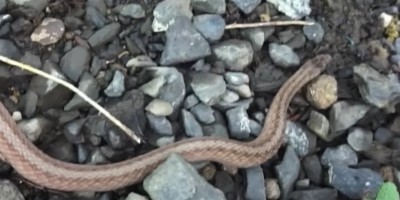 Brown Snake
Brown Snake
Latin name: Storeria dekayi
Size:5 to 15 inches
Venomous:No
You will find the brown snake in a wide assortment of habitat types across New Jersey, and it is not uncommon for property owners to turn over a pile of rocks and find this small but stout species hiding beneath it. The brown snake actually spends a great deal of its time underground, or burrowing beneath loose ground covering, such as leaf litter. The body blends in well, with its brown, tan, or gray colouration, often adorned with darker spots and pale patches. It also finds plenty of food underground, too — earthworms are the number one thing on the menu, but slugs and snails are also snapped up.
Red Corn Snake
Latin name: Pantherophis guttatus
Size: Up to 70 inches
Venomous: No
It is Southern New Jersey that you may encounter the common corn snake, also known as the red corn snake, which is such a quiet and placid snake species that it has become the most common beginner snake to keep in captivity. This has led to vanity breeding, with certain colourations bred together to create corn snakes that mimic the markings or colourations of other snakes, including the copperhead. Wild red corn snakes are often mistaken for the venomous copperhead and killed because of it. The corn snake is not venomous, however, and it has a pretty amicable temper although will bite when cornered.
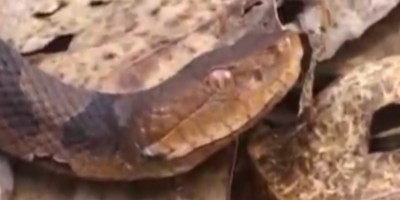 Copperhead
Copperhead
Latin name: Agkistrodon contortrix
Size: 20 to 40 inches
Venomous: Yes
The copperhead, also known as eastern or northern copperhead, is a species of special concern in the state of New Jersey, and sightings are said to be rather rare. The northernmost part of the state is where the snake is usually sighted, in old farmlands, woodlands, fields, rocky areas, and berry thickets.
Although this snake will use its tail like a rattlesnake, vibrating it from side to side to ward off predators, it is actually missing the vital rattle part, although it can sound very similar when the tail hits the ground or plants/vegetation around it.
Eastern Smooth Earth Snake
Latin name: Virginia valeriae valeriae
Size: 7 to 14 inches
Venomous: No
The smooth earth snake is commonly found in habitats that are damp and preferably close to bodies of water — edges of lakes, rivers and streams; towards the edges of forest or wooded areas; and in moist open, grassy areas. It is a fast, shy, and non-aggressive snake species that lays up to 6 eggs, up to twice per year, usually in the later part of summer and beginning part of fall.
This snake species enjoys a variety of insects as food, including spiders and insect larvae. It will also branch out into worms, slugs, snails, caterpillars, moths, and ants. It won’t constrict its food, instead relying on a strike approach — so the prey won't be any larger than what the snake can manage and successfully overcome.
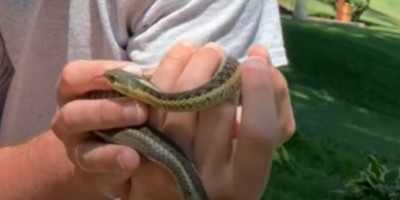 Eastern Garter Snake
Eastern Garter Snake
Latin name: Thamnophis sirtalis sirtalus
Size: 18 to 50 inches
Venomous: No
Garter snakes don't generally move far from a body of water, and they prefer to live in habitats that offer low-growing vegetation for protection and cover. Their diet is made up of mostly arthropods with soft bodies, including grasshoppers and crickets, butterflies, moths, and spiders. They will also eat larvae of moths and butterflies, ants, fly larva, snails, and various other bugs and insects.
This snake is the most common one that wild animal control are called to remove from residential and commercial properties, with old buildings and sheds offering everything the snake needs to hibernate through the cold winter.
Rough Green Snake
Latin name: Opheodrys aestivus
Size: 20 to 46 inches
Venomous: No
You are more likely to find the rough green snake climbing or dangling from trees in southern territories of New Jersey, camouflaged well with its bright green color and slightly textured scales. The latter is what sets it apart from the smooth green snake, which has, just as the name suggests, untextured and smooth scales. The texture is what helps the snake to climb trees.
This snake is quite common in its region, but despite being diurnal in nature, it is still quite rare to spot it out in the wild. The camouflage works very well in grasslands and tree leaves.
Smooth Green Snake
Latin name: Opheodrys vernalis
Size: 10 to 20 inches
Venomous: No
The smooth green snake might look slightly intimidating, with its bright green shade, but that’s where the intimidation factor stops. This small and slender snake likes to hide away in grass, keeping unknown and unbothered, and will flee at the slightest hint of trouble. It doesn't have venom on its side, and it isn't really big enough to defend itself against larger prey, so when fleeing isn't a viable option, it will secrete a fluid that smells musky and unpleasant, in a bid to ward off any oncoming predators.
This snake isn't even large enough to eat rodents; it feasts on worms, slugs, snails, spiders, moths, and other smaller insects.
Eastern Hog-Nosed Snake
Latin name: Heterodon platirhinos
Size: 15 to 42 inches
Venomous: No (Yes, but it doesn't affect humans)
The eastern hog-nosed snake is said to be present across most of the state of New Jersey, with the exception of highly human populated areas, preferring habitats that offer well-drained, sandy substrate. This snake is mildly venomous, but the rear-facing fangs make it difficult to inject venom into a human victim, and with the exception of allergies, the venom itself isn't potent enough to cause harm to anything other than the toads and frogs it targets and feeds on.
Although colors for this species may vary greatly, there are two common variations. It can either be almost completely black on the body, or a light brown-tan color with darker colored spots that run in rows down the body.
Eastern King Snake
Latin name: Lampropeltis getula getula
Size: 36 to 82 inches
Venomous: No
The eastern king snake is not common in most places across New Jersey, but you can find it in abundance in the most southern counties of the state, in the borders between wetlands and woodlands, and also around swamps and other water bodies. This is where it finds prey, including frogs, birds, bird eggs, rats, mice, and other snakes.
Some people may know this species more commonly as the chain snake, and that is because of the white/cream chain link pattern that decorates the black background color.
Coastal Plain Milk Snake
Latin name: Lampropeltis t. triangulum x L.t. elapsoides
Size: 24 to 52 inches
Venomous: No
When snakes of different species of subspecies come together to breed, which they can do, hybrid snakes are formed — and the coastal plain milk snake is a prime example of that. When you cross a scarlet snake with an eastern milk snake, you get yourself this fine-looking species. It is quite a rare species in the state of New Jersey, and looks very much like the eastern milk snake, but the tan-gray background color can be more yellow, and the red-brown blotches that form an almost leopard print-like pattern are brighter and more red-orange.
Eastern Milk Snake
Latin name: Lampropeltis triangulum triangulum
Size: 24 to 52 inches
Venomous: No
As well as finding the eastern milk snake in rocky hillsides, woodlands, forests, and the banks of rivers, streams or lakes, you may also find it in or around old houses, farmlands, old barns and outbuildings, and abandoned or neglected spaces. In short, anywhere that you will find rats and mice, you will also find the eastern milk snake in the state of New Jersey.
This snake is also known by a string of other names, mostly because of its bright red-brown patches of color over a lighter gray or tan background color, including scarlet milk snake, leopard-spotted snake, and checkered adder.
Northern Pine Snake
Latin name: Pituophis melanoleucus melanoleucus
Size: 45 - 70 inches
Venomous: No
You may encounter the northern pine snake in southern areas of the state of New Jersey, particularly the pine barrens. With population numbers declining rapidly, it is now on the New Jersey threatened species list, so there is a good chance that you won't ever come across this non-venomous but slightly intimidating snake.
As well as rattling its tail, making a rattling vocal noise, and also hissing, the northern pine snake will make itself appear as large as possible when faced with a predator or threat. It will often give a number of ‘warning shots’ before actually biting, but continued provocation will eventually result in a non-dangerous but still very painful bite.
Queen Snake
Latin name: Regina septemvittata
Size:13 to 30 inches
Venomous: No
The queen snake is a rather dull looking snake, often with dark, matte brown, gray, or olive-colored scales. Occasionally, the body will have faint stripes that run down it, and there are commonly darker stripes running along the yellow-cream underbelly. This species is often confused with other crayfish snakes, but they have more pronounced, bug-like eyes.
Although the queen snake was quite common in New Jersey at one point, it is now believed that the species has been extirpated. It is a species that readily feasts on crayfish, so lives in areas where crayfish are abundant — rocky-bottomed bodies of fresh running water.
Northern Black Racer
Latin name: Coluber constrictor constrictor
Size: 34 to 77 inches
Venomous: No
This snake prefers to live in woodland areas, but it is not uncommon for animal control to get a call about a rogue northern black racer in residential back gardens or parks. It is a very fast snake (as the name implies), that is almost entirely black, with some occasional lighter-colored patches around the throat.
People often believe this snake is a venomous rattlesnake as the timber rattlesnake also inhabits similar areas of New Jersey, because the racer vibrates its tail in a similar way when faced with predators. It is actually the snake beating against plants or the ground that makes the noise, but it’s still a pretty good rattlesnake imitation.
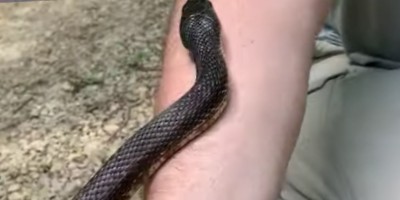 Black Rat Snake
Black Rat Snake
Latin name: Elaphe obsoleta obsoleta
Size: 34 to 100 inches
Venomous: No
The black rat snake is also known as the black snake, pilot black snake, or western rat snake, and it is found in more rural regions of New Jersey, including farmlands, rocky hillsides, and woodland areas. It is an excellent climber and will use trees to bask and get away from predators, but it is just at home in aquatic habitats, too.
This snake is known as the pilot black snake because of its winter behavior. It regularly dens with other snakes, including the venomous timber rattlesnake and equally venomous copperhead, and was once believed to lead or ‘pilot’ them into the den.
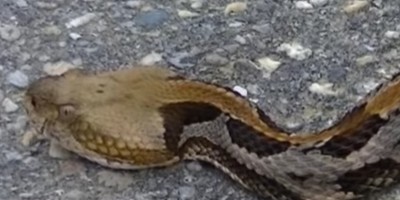 Timber Rattlesnake
Timber Rattlesnake
Latin name:Crotalus horridus
Size: 36 to 60 inches
Venomous: Yes
You may also know this venomous snake species as the canebrake rattlesnake, and the timber rattlesnake is a rare snake these days. Although venomous, it is shy and elusive, much preferring to hide or ward off predators with the infamous rattling tail. Reports of human bites from this snake are rare, but the snake does have a high venom yield and contact should be avoided. During the winter, it is common for the timber rattlesnake to go into a state of brumation along with other snakes, including the black rat snake and venomous copperhead.
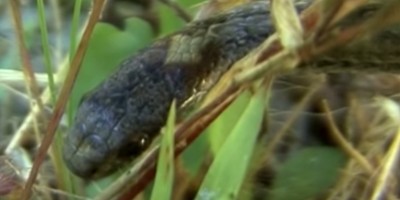 Northern Red-Bellied Snake
Northern Red-Bellied Snake
Latin name: Storeria occipitomaculata occipitomaculata
Size: 8 to 16 inches
Venomous: No
This snake is pretty tiny and well-camouflaged, so there's a chance that you could have walked right on by the northern red-bellied snake without ever having known. It’s actually quite a common species in the state of New Jersey, but sightings are rare. As well as being tiny, this snake is very secretive, likes to hide underneath things like boulders, rocks and logs, and usually flees at the very first sign of danger. As the name implies, it has a red belly, but the top of the snake is often a very dull brown or gray color, hiding it well in the woodlands and hedgerows it inhabits.
Eastern Ribbon Snake
Latin name: Thamnophis sauritus sauritus
Size: 18 to 40 inches
Venomous: No
It would be easy to get this snake mixed up with the garter snake, also found in New Jersey, but the eastern ribbon snake does have some differences. The garter snake’s tail is shorter and its body is slightly more plump, and the ribbon snake tends to have stripes running down the side of the body, which the garter snake doesn't alway shave.
Also known as the common ribbon snake, this is just one subspecies found in the south-east US. It inhabits water bodies and areas around them, such as rivers and streams, but they do not dive into the water like other semi or highly-aquatic snakes do; instead, they float or glide.
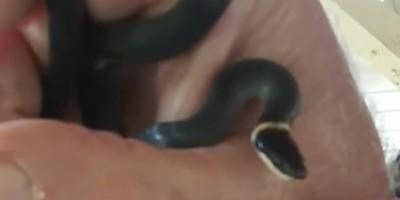 Northern Ring-Necked Snake
Northern Ring-Necked Snake
Latin name: Diadophis punctatus edwardsii
Size: 10 to 15 inches
Venomous: No(Yes, but it doesn't affect humans)
The northern ring-necked snake is a mostly black or dark brown snake with a ring of lighter color around the neck, usually cream, yellow-cream, or dirty-white in color. This band of color is solid, unlike the southern ring-neck snake, which has a little gap in the band.
This snake eats three main foods: lizards, earthworms, and salamanders; although there are other prey items on the menu, including ants and other insects. One of the biggest predators for this snake is the domestic cat (in urban areas), alongside other [larger] snake species, birds of prey, and even bullfrogs.
Southern Ring-Necked Snake
Latin name:Diadophis punctatus punctatus
Size:10 to 15 inches
Venomous: (Yes, but it doesn't affect humans)
This particular subspecies of ring-neck snake enjoys habitats with high moisture levels, such as floodplains and lowlands. This is where it finds the majority of its prey — salamanders, earthworms, lizards, small fish, and occasional arthropods. It is not known to be an aggressive snake, but it does deliver a rather foul-smelling fluid from its anal glands in a defense mechanism. It is becoming more and more common for home and property owners to find these snakes in garages, sheds, or other quiet buildings.
Northern Scarlet Snake
Latin name: Cemophora coccinea copei
Size:14 to 20 inches
Venomous: No
The northern scarlet snake is a nocturnal one, rarely active during the day even in the height of summer. It is also a very shy and non-confrontational snake, much preferring to slither away or use a musky-smelling fluid to try and keep predators and attackers at bay. It is not recommended to come close enough to touch wild snakes, but despite mimicking the colourations of various other venomous species, this one rarely bites and doesn't inject venom. It's teeth are actually oversized and designed to crack open reptile eggs — the snake's main food source.
Northern Water Snake
Latin name: Nerodia sipedon
Size: 20 to 55 inches
Venomous: No
Northern water snakes are not a venomous species of snake, but they are often confused with the venomous rattlesnake and killed by humans as a result. This snake lives mostly in water, being semi-aquatic, and they feed on a wide variety of prey items, including fish, toads, newts, salamanders, insects, and crayfish. They’ll also eat dead animals in the water, as well as rodents and other small mammals. Because of this, they can actually prove beneficial to humans, keeping waterways clear, keeping animal and insect populations in check, and generally tidying up after other animals.
Eastern Worm Snake
Latin name: Carphophis amoenus
Size:Under 15 inches
Venomous: No
This particular species of snake is often confused with a couple of other species, also found in New Jersey: the brown snake and the earth snake. With a dark brown color on the top and a light, brighter, pink or red shade across the bottom, you'd be forgiven for thinking the bright shade makes the species a venomous one, but it's not. It’s also not a particularly aggressive species, much preferring to spend its time away from predators and prying eyes, beneath loose leaves, buried in soft or sandy/rocky soils, or under piles of rocks/logs.
Western Worm Snake
Latin name: Carphophis vermis
Size: 7 to 12 inches
Venomous: No
There's a good chance that you won't ever see this fossorial snake species in the wild; it is very shy, very secretive, and spends the majority of its time either underground or hidden beneath loose vegetation, debris, and litter on the surface. It can sometimes be seen beneath boulders, rocks, logs, and other similar items when they are turned over, but it isn’t usually far from a patch of forest. Experts don't know much else about this elusive snake, and even its breeding process is somewhat of a mystery.